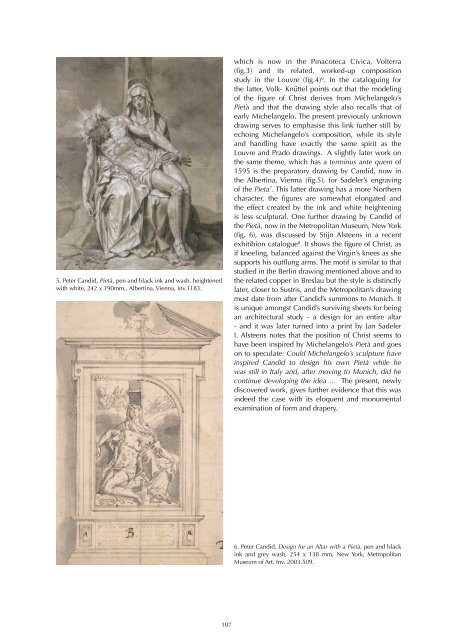Create successful ePaper yourself
Turn your PDF publications into a flip-book with our unique Google optimized e-Paper software.
5. Peter Candid, Pietà, pen and black ink and wash, heightened<br />
with white, 242 x 190mm., Albertina, Vienna, inv.1183.<br />
which is now in the Pinacoteca Civica, Volterra<br />
(fig.3) and its related, worked-up composition<br />
study in the Louvre (fig.4) 6 . In the cataloguing for<br />
the latter, Volk- Knüttel points out that the modeling<br />
of the figure of Christ derives from Michelangelo’s<br />
Pietà and that the drawing style also recalls that of<br />
early Michelangelo. The present previously unknown<br />
drawing serves to emphasise this link further still by<br />
echoing Michelangelo’s composition, while its style<br />
and handling have exactly the same spirit as the<br />
Louvre and Prado drawings. A slightly later work on<br />
the same theme, which has a terminus ante quem of<br />
1595 is the preparatory drawing by Candid, now in<br />
the Albertina, Vienna (fig.5), for Sadeler’s engraving<br />
of the Pieta 7 . This latter drawing has a more Northern<br />
character, the figures are somewhat elongated and<br />
the effect created by the ink and white heightening<br />
is less sculptural. One further drawing by Candid of<br />
the Pietà, now in the Metropolitan Museum, New York<br />
(fig. 6), was discussed by Stijn Alsteens in a recent<br />
exhitibion catalogue 8 . It shows the figure of Christ, as<br />
if kneeling, balanced against the Virgin’s knees as she<br />
supports his outflung arms. The motif is similar to that<br />
studied in the Berlin drawing mentioned above and to<br />
the related copper in Breslau but the style is distinctly<br />
later, closer to Sustris, and the Metropolitan’s drawing<br />
must date from after Candid’s summons to Munich. It<br />
is unique amongst Candid’s surviving sheets for being<br />
an architectural study - a design for an entire altar<br />
- and it was later turned into a print by Jan Sadeler<br />
I. Alsteens notes that the position of Christ seems to<br />
have been inspired by Michelangelo’s Pietà and goes<br />
on to speculate: Could Michelangelo’s sculpture have<br />
inspired Candid to design his own Pietà while he<br />
was still in Italy and, after moving to Munich, did he<br />
continue developing the idea … The present, newly<br />
discovered work, gives further evidence that this was<br />
indeed the case with its eloquent and monumental<br />
examination of form and drapery.<br />
6. Peter Candid, Design for an Altar with a Pietà, pen and black<br />
ink and grey wash, 254 x 138 mm, New York, Metropolitan<br />
Museum of Art, Inv. 2003.509.<br />
107
















